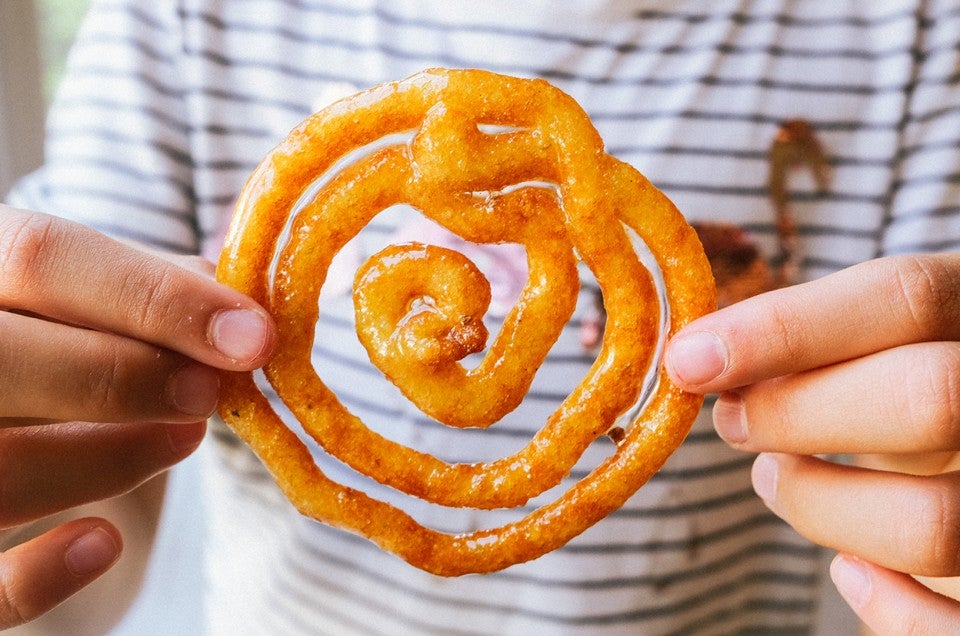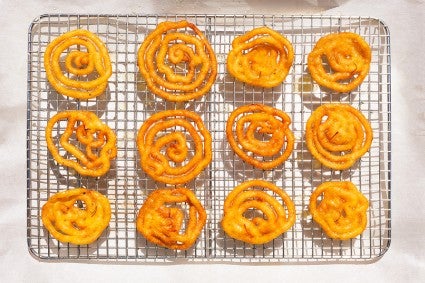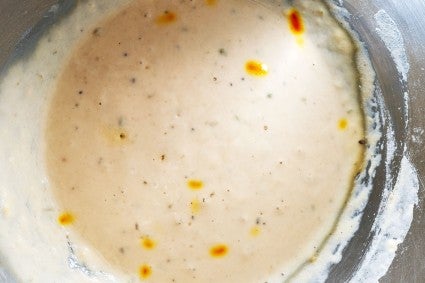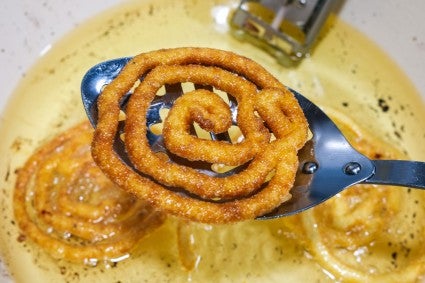Jalebi: A South Asian sweet worth breaking out the fryer for
How to make the wildly popular treat in your home kitchen.


We're excited to welcome writer and baker Pooja Makhijani back to the King Arthur blog. Below, she shares how to re-create the beloved South Asian street food jalebi in a home kitchen.
* * *
The first time I heard the summer 2021 dance anthem “Jalebi Baby,” I assumed the lyrics were nonsense. Would someone really sing a song about my favorite South Asian confection? A Pakistani American friend finally clarified: Yes, the viral TikTok hit was indeed about my beloved sweet.
Jalebi is a funnel-cake-like treat made by piping spirals of slightly fermented batter into hot oil, and then soaking the whorls in warm sugar syrup. Making jalebi is a bit fiddly. It requires both a keen understanding of fermentation and temperature and some comfort with candy-making and deep-frying. That said, the fuss is very worth it — the result is a delicious treat that’s crispy on the outside, chewy on the inside, and oozes sticky syrup with every bite.

Like many foods now strongly associated with South Asian cuisine, jalebi traces its roots to Persia. By most historical accounts, jalebi is of West Asian provenance and made its way to South Asia in the 14th or 15th century via Turkish and Persian traders. The precursor to jalebi is the zalabiya, an ancient pastry that appears in a 10th-century Baghdadi cookbook, Kitab-al-Tabikh. It's known by different names across Asia — zalabiya in Arabia, mushabbak in Levant, and zulbia in Iran.
After the jalebi’s introduction to South Asia — which occurred as early as the 15th century, when recipes for jalebi could be found in cookbooks across the subcontinent — it became a ubiquitous part of South Asian foodways. Jalebi are distributed to friends and family to mark births and weddings, and for Eid and Diwali. They are sometimes offered as prasad, a Hindu religious offering. Jalebi are eaten at breakfast with puri (deep-fried flatbread); at teatime with chai; or just because a craving strikes, when they're dunked in milk or served with rabri, a milk pudding-like dessert. Here are the keys to successfully making them at home.

Fermentation is a widely used process in South Asian cooking. Here, all-purpose flour and besan (gram) flour are fermented overnight using yogurt to seed the batter. Yogurt is the source of lactic acid bacteria, vital to fermentation. This fermentation not only gives the sweet its characteristic sour flavor, but also encourages gluten formation. The resulting elasticity makes the batter easier to pipe into continuous swirls and contributes to the texture of the final product. One of jalebi’s distinct characteristics is its bit of chew!
I often use two digital thermometers when I make jalebi. The sugar syrup must be brought to between 223°F and 235°F (also known as the one-string or thread stage). If you don’t have a candy thermometer, don’t fret. You can measure if the syrup has reached the right temperature by drizzling a teaspoon of syrup into a bowl of cold water. Retrieve the sugar and press it gently between your thumb and forefinger; if the syrup forms a loose, thin thread, it’s ready.
Let cool to between 150°F and 160°F — the saucepan should be warm to the touch — at which point it’s ready to use. Keeping tabs on the temperature ensures that the syrup will soak the fried dough evenly and will set to form a hard shell. Too cold? The syrup won’t get absorbed. Too hot? The syrup will soften the jalebi’s crust. Either way, you'll end up with soggy sweets — and no one wants that.

The oil for frying must also hover around 330°F, a touch lower than normal temperature range for deep-frying. At higher temperatures, the jalebi will not hold its shape as it fries. If you don't have a thermometer, determining oil temperature is a bit of trial and error while frying your first few jalebi— too cool and the jalebi deflate and sink to the bottom; too hot and they disintegrate and brown immediately. Adjust the heat accordingly as you keep frying. (These wonky-shaped pieces are still tasty!)
Here's that frying step in action so you can see how to make the distinct swirled shapes:
The spice gives the jalebi batter its striking golden orange hue and adds complex flavor notes to the finished dish: earthy and grassy, floral and sweet. Jalebi batter can be colored with food coloring, but there’s really no replacement for saffron, flavor-wise. When buying saffron, look for ethical sourcing, deep red threads with a thin yellow tendril on one end, and — if you can smell it — a distinctly heady, musky aroma.
My most vivid memories of traveling to India as a child include being utterly mesmerized by jalebi wallahs deftly twirling batter into vats of hot oil, then biting into a hot jalebi straight from the fryer, soaked only for a minute or two in sugar syrup. But jalebi is only one of several South Asian sugar-coated, fried batter sweets; each is unique in flavor and shape. Flower-shaped imarti or jangiri, which originated during the Mughal era, are made of a fermented urad dal (split black lentils) paste. Chhena jalebi, from the coastal Indian state of Odisha, uses chhena (milk curds) as its primary ingredient. Net-like geeyar are served on the spring festival of Holi in Sindhi homes — these are of my ancestral cuisine! South Indian karupatti mittai incorporate palm jaggery, an unrefined sugar.
By preparing street food treats like jalebi yourself, I hope my recipe brings a little bit of that magic into your home kitchen.

